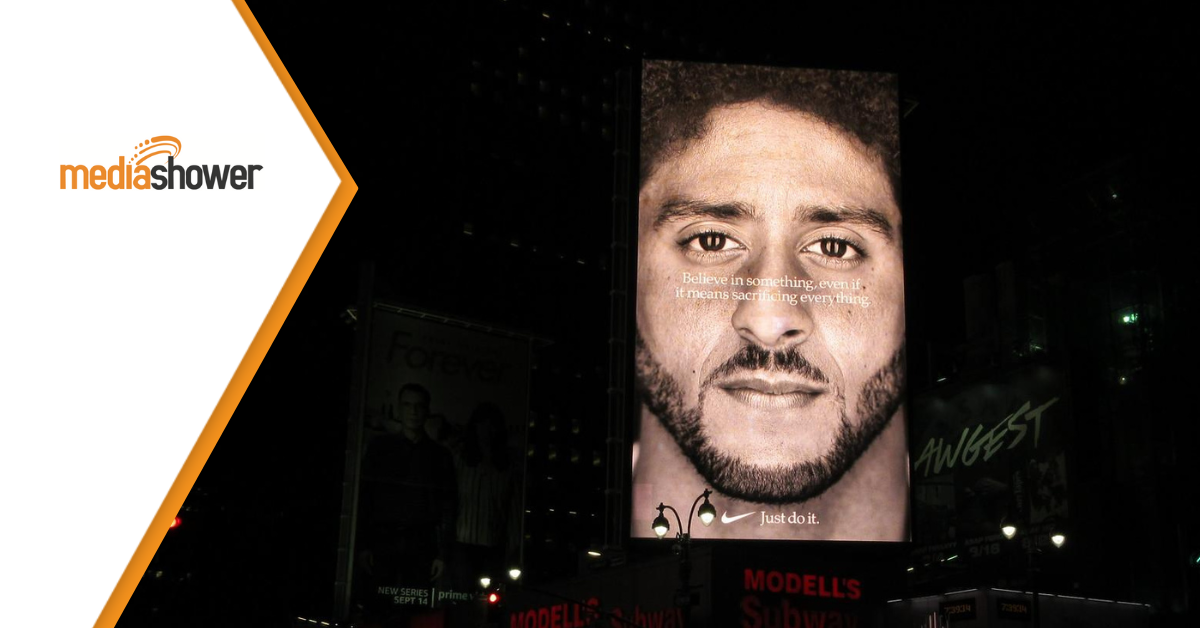
TL:DR: In a 2018 two-minute advertisement by Nike, Colin Kaepernick demonstrates how communicators can stay strong when taking controversial stances. Or, as he puts it in the speech, “Believe in something, even if it means sacrificing everything.”
So What? Communicators of all stripes will sometimes need to discuss something difficult or controversial or take action and justify it after the fact. Kaepernick’s actions on and off the field show us how to face those problems with tact, grace, and generosity.
Advertising is a great way to bring attention to products and services. But what happens when such advertisements attempt to step into controversial topics to make a statement about the world?
In the case of Nike, they featured a polarizing figure in Colin Kaepernick to reflect the values of change, growth, and social justice associated with their brand.
The Controversy of Kaepernick
In a 2016 preseason NFL game, a reporter noticed San Francisco 49ers quarterback Colin Kaepernick sitting on the bench rather than standing when the national anthem played.
Asked about it after the game, Kaepernick explained why he was sitting, referring to multiple recent incidents where police officers had killed people of color:
“I am not going to stand up to show pride in a flag for a country that oppresses black people and people of color. To me, this is bigger than football, and it would be selfish on my part to look the other way.”
He also said he’d continue to do so until the flag better represented its values. After a discussion with a veteran who was also an NFL player, Kaepernick began kneeling during the anthem instead, as it was felt to show more respect for veterans and currently serving military personnel. He did so throughout the entire 2016 season.
It was a small act of personal protest that quickly became a lightning rod of controversy… controversy that eventually led Colin Kaepernick to “remain unsigned” entering into 2017. He was accused of disrespecting America, disrespecting veterans, and showing disdain for his team and teammates.
So, with all this controversy, why would Nike, the largest shoe brand in the industry, feature Kaepernick in a major ad campaign?
Using Metaphor to Frame a Message
The clear message that leads this advertisement is simple and yet powerful: that greatness is about overcoming the odds to do something extraordinary.
There is typically no better metaphor for this than sports.
Kaepernick narrates a series of statements about what it means to achieve your dreams:
“If they laugh at what you think you can do, good. Stay that way. Because what non-believers fail to understand is that calling a dream crazy is not an insult; it’s a compliment.
Don’t try to be the fastest runner in your school or the fastest in the world, be the fastest ever.
[…]
If you’re born a refugee, don’t let it stop you from playing soccer for the national team at age 16.
Don’t become the best basketball player on the planet, be bigger than basketball.
Believe in something, even if it means sacrificing everything.
When they talk about the greatest team in the history of the sport, make sure it’s your team.
If you have only one hand don’t just watch football, play at the highest level.
If you’re a girl from Compton, don’t just become a tennis player, become the greatest athlete ever.
Yeah, that’s more like it.
So don’t ask if your dreams are crazy, ask if they’re crazy enough.”
The speech is set against visuals of athletes who overcame a wide range of challenges, such as 10-year-old wrestler Isaiah Bird, who was born without legs; Muslim female boxer Zeina Nassar; and high school football linebacker and homecoming queen Alicia Woolcott. They’re featured alongside better-known athletes such as Serena Williams, LeBron James, and Odell Beckham Jr.
We’re all familiar with this metaphor, yet it works–it shows us that overcoming severe challenges is possible. It motivates us to think about that as an aspirational goal. Accordingly, this attitude is reflected in the Nike brand (a more inspiring version of “Just Do It”).
But why Kaepernick? In this ad, he is positioned in the same light: as someone who bucked trends and put himself in a position to stand up for what he thought was right.
We can see that this oldest form of communication, the metaphor, tells the story we experience in this ad and pushes us to make the connections between success, overcoming adversity, athletes, Kaepernick, and, ultimately, Nike.
Put Others First to Make a Big Statement

Image Attribution: Erik Drost
Nike faced difficulty itself when it continued its relationship with Kaepernick. The deal was extended with little fanfare and had solid business logic behind it, as Kaepernick’s jersey quickly became one of the NFL’s top sellers.
Sometimes, the best way to communicate with people is to support them, to let them speak, and to let that resonate with your audience.
In the case of Nike and Kaepernick, Nike knows exactly who their audience is… young people, often from diverse economic and social backgrounds, who look to sports figures and athletes as role models. These audiences are often embedded in social contexts where social justice is a significant topic. And Kaepernick is recognizable in that context.
So, it’s a simple rhetorical move to let him speak on the topic as a demonstration of support of that message, as a sharing of the sentiment.
In more casual or marketing-focused approaches, this might be as simple as using social proofs like testimonials or quotes from industry leaders to show that you aren’t alone in your way of thinking. More importantly, you provide a speaker with the ethos necessary to speak to a wide range of viewers or readers without putting words into their mouths.
Class and Eloquence Create an Ethos
Speaking of ethos…
In his speech, Kaepernick never speaks directly about himself or his choices. He does mention his situation obliquely: During the line “Believe in something, even if it means sacrificing everything,” he’s shown looking at an American flag projected on a building before turning to look at the camera.
Part of this is simple courtesy: Kaepernick never conflates what others went through with his experiences, nor does he imply they agree with his stance. He never tries to speak for anyone, letting their actions and achievements speak for themselves just as they did for him. He’s simply another example of dreaming crazy.
This highlights that we all face different obstacles in achieving our dreams and that clearing them is to be celebrated no matter who you are. There isn’t a “ranking” of challenges in this speech: what the athletes move past ranges from personal medical problems to larger social struggles. Nike trusts the audience to understand that, granting those fights a measure of respect.
It also helps make the speech timeless; even if you have no idea who Kaepernick is, the sentiment comes through. You’ll notice that’s true of everyone in the video; while you can look them up to learn more about their stories, you don’t need to know their names or pasts to grasp the context.
Making Big Statements as Brand Statements
Individually, these observations tell us some techniques we can use to approach marketing and content. Together, however, we’re seeing a masterclass in what it means to be a brand in the world, to make a statement of value as that brand, and to do it effectively.
When Nike was challenged about their association with Kaepernick, the company pushed back, saying their work with the former NFL player wasn’t simply about selling merchandise but about reflecting a set of values that the brand held dear.
This is a tricky balancing act for brands, where political statements are seen as suspect. But Nike, with class, eloquence, and an eye for the power of metaphor and sports, was able to weave a story about overcoming adversity and standing up for what’s right, all in 120 seconds.
If you need help crafting effective communication for your target audience, Media Shower wants to use our expertise for your benefit. Get a free trial and find out for yourself.
